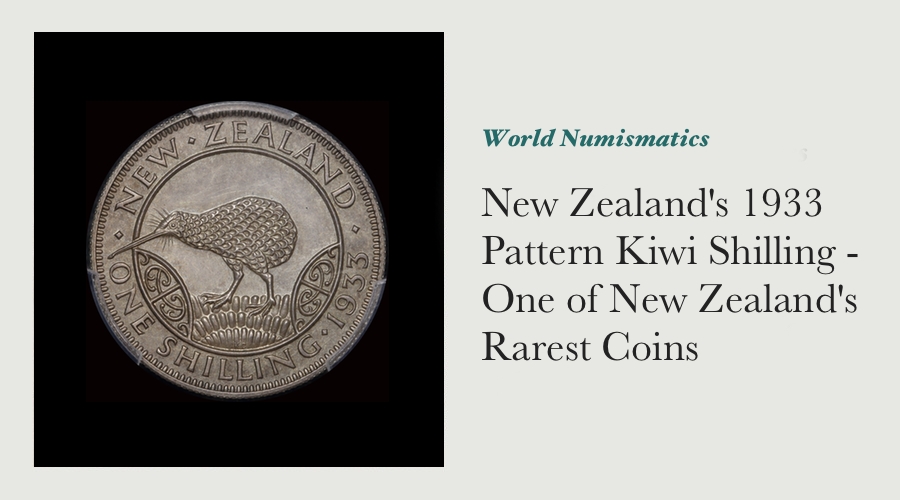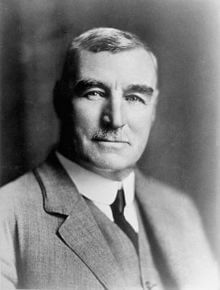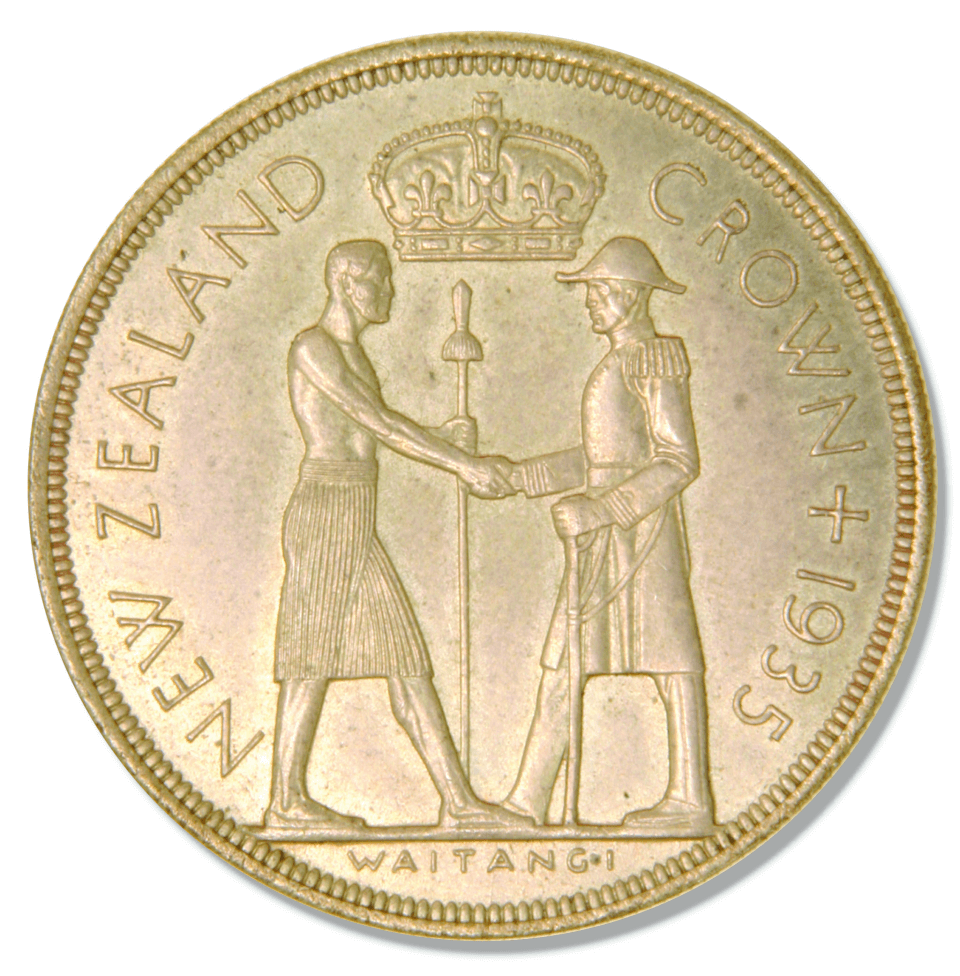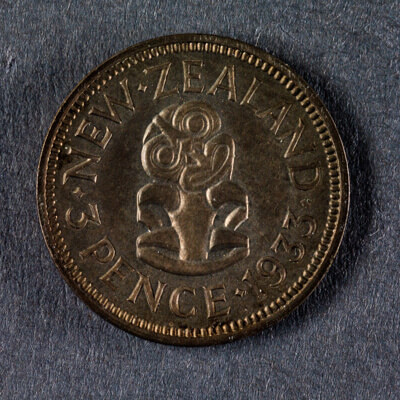New Zealand's 1933 Pattern Kiwi Shilling - One of New Zealand's Rarest Coins

The 1933 pattern Kiwi shilling is one of New Zealand’s most historic coins, and also lays claim to the title of New Zealand’s rarest coin. Only two examples were struck, its existence is testament to the robust process that conceived New Zealand’s proud national coinage.
It is believed to have been struck between August and October 1933, at least two months before the first New Zealand coins entered circulation, and during the period in which proposed designs were moving from theory to tangible reality.
.jpg)
Monetary Stability Until Australia’s Federation and the Great Depression
Until the early 1900’s, the composition of New Zealand’s circulating coinage was reasonably stable. As with most colonies and dominions of the British Commonwealth, the coins that greased the wheels of commerce across New Zealand were exactly the same type of pounds, shillings and pence that were used throughout the United Kingdom.
Australia’s Federation and the advent of the Great Depression soon changed that however.
Although Australian copper and silver coins had not been officially accorded legal tender status by the New Zealand government after they were introduced in 1910, as Australia’s coins had the same intrinsic value as their equivalent British coins, they were accepted readily throughout New Zealand.
Between March and December 1931, the Australian Commonwealth government devalued the Australian Pound against the British Pound by 25%.[1] This led to a sharp rise in the amount of Australian copper and silver coins being imported into New Zealand[2] - 30% of the coins circulating throughout New Zealand were Australian.[3]
The New Zealand Government then devalued the New Zealand Pound against the British Pound by 25% in January 1933[4], an act that quickly increased the amount of British coins that were smuggled out of New Zealand[5].
It was in the face of this costly and unsustainable movement of physical capital that a member of the New Zealand Parliament tabled a private member’s bill “to establish a separate coinage.”[6]
Distinctive New Zealand Silver Coin
Gordon Coates was the Minister for Finance at the time, he cabled Athol Mackay in New Zealand’s High Commissioner in London to advise that “Only effective remedy appears to be establishment distinctive New Zealand silver coin…”[7]
Mackay contacted Sir Robert Johnson, the Deputy Master of the Royal Mint in London, about the situation. Johnson advised that “minting could immediately commence once designs and dies were approved by the High Commissioner on behalf of the New Zealand government.”[8] Johnson also called for “…early suggestions for suitable objects…” to be included within the reverse designs. His initial thoughts were that the larger coins could depict sections of the Arms of New Zealand and that the smaller coins could possibly include “typical Maori design”.[9]
Late in March 1933, two leading coinage designers were briefed about the project - George Kruger Gray and Percy Metcalfe. Initially, the New Zealand government didn’t make any specific recommendations regarding design subjects, but did provide a wide range of photographs and books from which the designers could select appropriate elements. It could be argued that this contribution was the extent of the input that the Royal Mint expected from New Zealand.
Both of Johnson’s comments about the approval process and the designs most likely to be appropriate clearly indicated how he would approach the coming months. It was Johnson’s preference or understanding that decisions regarding coinage designs would be made by New Zealand’s High Commissioner, those in New Zealand understandably saw the situation rather differently.
May 1933 - Uncertainty Takes Hold.jpg)
In May 1933, seemingly without explicitly advising the Royal Mint of the High Commission in London, Coates appointed a “Coinage Design Committee” that included representatives of banks, commerce, the Audit Department and the recently founded New Zealand Numismatic Society. It was at that point that the process by which New Zealand’s coinage became rather complicated.
The Prime Minister of New Zealand, George Forbes, was in London to attend an economic conference between June and July 1933, so a meeting between eight representatives of the Royal Mint and five from the New Zealand government was held on June 28th, 1933.
June 28th 1933 - the Royal Mint Advisory Committee Meets
Each of the designs submitted by both artists were discussed in great detail. Kruger Gray’s proposed design for the half crown was accepted subject to several minor amendments, while his initial design for the shilling was generally liked, “… the representation of the bird in particular being approved by the representatives of New Zealand.[10]” The initial designs for the smaller denominations were either rejected outright or referred for significant modifications.
Prime Minister Forbes is recorded as having approved the “draft designs” presented at the Advisory Committee in London, after which Johnson authorised Kruger Gray to make the amendments required to move each of the designs to an acceptable stage.[11]
The Design Revisions Begin
Kruger Gray submitted his revised designs for the sixpence and threepence, and during the month of June, made minor amendments to his designs for the shilling and florin.
The half crown was the first design to be approved, on July 18th 1933 by Thomas Wilford, New Zealand’s High Commissioner to London.
The New Zealand-based Coinage Committee that had been convened by Finance Minister Coates met several times throughout May and June. In stark contrast to Forbes’ tacit approval of the initial series of designs presented by the Royal Mint, in their first report delivered July 1st 1933, the Coinage Committee resolved to recommend “truly distinctive designs”, even if this delayed the coins being issued.[12]
They proposed that the kiwi be represented on the florin; that a crouching Maori figure be represented on the shilling; the huia bird was to feature on the sixpence, while the threepence was to show “two Maori panels”.[13]
Prime Minister Forbes did not endear himself to the Coinage Committee when he advised Sir Robert Johnson during a meeting around July 18th that he proposed to “…disregard the observations of the local Committee.”[14]
Undeterred, and most likely without any knowledge at all of Forbes’ decision, on August 18th the Coinage Design Committee advised the Royal Mint via the High Commissioner that it “unanimously reiterated the requests made the previous month[15]” that wholesale revisions be made to the reverse designs.
In his written response on August 23rd, Sir Robert Johnson challenged the authority that Coates and the Coinage Design Committee presumed to have “…I think the [High Commissioner] will agree with me, that at our last meeting with the Premier and the other Ministers present, the Premier definitely decided that the Committee was going beyond its province in laying down the law about designs at all, and that in any case his decision was final[16].”
Work On the Draft Designs - Far Advanced
Johnson went on to advise that work on the draft designs was “far advanced”, and that “It is therefore proposed to adhere to the Prime Minister’s decision. First issues will therefore be made accordingly.[17]” Johnson pointedly mentioned that the “Maori figure, however, which is suitable for a medal could not be satisfactorily represented on so small a piece as one shilling.” When taken together, both of these statements can explain the existence of the 1933 pattern Kiwi shilling.
.jpg)
Staff at the Royal Mint were aware of the economic impact that a lack of domestic coinage was having on the New Zealand economy, and in the face of the apparent conflict between Forbes and the Coinage Committee, resolved “… we should proceed with the work and run the risk.[18]”
This statement is a clear indication of the divergent paths the Royal Mint and the Coinage Committee were taking during this period.
Prime Minister Forbes was scheduled to arrive back in New Zealand on September 20th 1933, at which time Royal Mint staff expected him to “decide matters on the spot.” A week before Forbes was due back, Finance Minister Coates cabled London again to instruct “please proceed without delay” with revisions to the designs.
On September 29th 1933, Sir Robert Johnson advised the New Zealand government that “…all dies based on designs approved in principle by yourself completed and ready striking coins which would be shipped in a few weeks.”
October 4th 1933 - All Uncertainty Ends
The telegram that Forbes sent to London on October 4th 1933 ended all uncertainty and gave a clear indication where the real authority lay: “Please carry out as a matter of urgency instructions issued by Minister of Finance.”[19]
In October 1933, Kruger Gray made the required amendments to the florin and the sixpence designs, and re-modelled the shilling and threepence. This change in focus ends the period in which the pattern Kiwi shilling could have been struck.

It is telling that the shilling and threepence were the last two denominations to be issued into circulation - Sir Robert Johnson was deeply concerned that the reverse designs for these denominations proposed by the Coinage Committee could not be effectively reproduced on circulating coins.
The difficulty with the shilling design was “… so great that it cannot be taken up successfully with the single blow which is a necessary feature in coining, since the effigy of His Majesty on the obverse side already requires a considerable mass of metal on the other side.”[20]
It is quite possible that the pattern Kiwi shilling was struck by the Royal Mint in anticipation of serious production difficulties being encountered with the proposed Maori design.
Regarding the threepence reverse, Coates and the Coinage Committee had advised that it was “prepared to accept [a single] Mere with string attached.” After some discussion with Kruger Gray, Johnson advised Coates that the design should be amended to include two crossed meres.
The records show that the final amendments to each of the designs were implemented and passed in the final weeks of 1933.
Production Begins and the Finished Coins Enter Circulation
The half crown was the first denomination to enter circulation, on November 28th 1933. The sixpence was first seen in late January 1934; the florin in mid February 1934; the threepence in mid March 1934, and finally the shilling in early April 1934.

Johnson continued to correspond with the Coinage Committee as the coins were introduced into circulation in the early months of 1934. In one letter, he continued to demonstrate his faith in Kruger Gray’s initial designs “…the kiwi would have looked more effective on the shilling and the crouching Maori figure on the florin.[21]”
Discussion of the nation’s new coinage in the newspapers of the day clearly demonstrated the positive way they were received by the public.
As time passed, the adage that “all’s well that ends well” was proven yet again. The introduction of New Zealand’s national coinage brought an end to the illicit export of coins to Australia and Great Britain, and engendered a great deal of national pride.
In his Annual Report for 1933, Sir Robert Johnson spent no less than two pages recounting the problems that were experienced on the journey to the coins being successfully introduced into circulation, which was somewhat more than an economy the size of New Zealand might otherwise command in that report.
It is perhaps telling that the provenance of both of the 1933 pattern Kiwi shillings can be traced back to the Deputy Master of the Royal Mint, Sir Robert Johnson.
An auction listing for one of the examples contained the following statement: “A letter from Hagley states that he obtained the coin from the Mint Master in London in 1933 and that only two were struck in silver to test the dies.”
An auction listing for the other example stated “Mr. Seaby had indicated he obtained the piece from “a mint official”, an attribution that is taken to be a polite reference to Sir Johnson.
Johnson clearly had a strong drive to ensure New Zealand’s economic woes were addressed as quickly as possible by the introduction of a national coinage, he also had firm ideas on the designs that could achieve that goal most efficiently.
The shilling was the most contentious denomination in the series, the revised design was the one most likely to be rejected for technical reasons once it was tested under manufacturing conditions.
It should be little surprise then that Johnson ensured patterns of the shilling were struck, ready if the revised design could not be effectively struck by the minting presses. Although a cable dated 29th September 1933 stated that “…all dies based on designs approved in principle by yourself [Prime Minister Forbes] completed and ready striking coins…”, patterns of the sixpence, florin and half crown have never been sighted.
A pattern of Kruger-Gray’s version of the Tiki threepence reverse design is held by the Reserve Bank of New Zealand, however at present is not known in private hands.
The 1933 pattern Kiwi shilling has chronological, if not historical, precedent over the well-known 1935 pattern Waitangi crown. The idea of a commemorative crown was not even proposed until late October 1933, Percy Metcalfe’s first design was not presented to the Royal Mint Advisory Committee until July 1934, and the famed pattern Waitangi crown (last sighted at auction in Sydney in November 1989, and rather sensationally now believed to have been lost to collectors) was not prepared until the middle of 1935. That pattern Waitangi crown represented just one of the five stages of revisions that were made to New Zealand’s first commemorative coin, whereas the pattern Kiwi shilling is easily the rarest coin available to collectors that represents the introduction of the entire series of New Zealand coinage.
Whether Johnson kept the pattern Kiwi shillings as a personal memento of a project that was both challenging and ultimately rewarding will never be known.
[1] Schedvin, C.B. (1970), Australia and the Great Depression: A Study of Economic Development and Policy in the 1920s and 1930s, Sydney University Press, Sydney, p41
[2]
[3] Stocker; Mark, "A Very Satisfactory Series - The 1933 New Zealand Coinage Designs" in the British Numismatic Society Journal, 75, 2005, p 143.
[4] Reserve Bank of New Zealand: Bulletin, Vol. 75, No. 1, March 2012
[5]
[6] Stocker op cit, p143
[7] Stocker op cit, p144
[8] Stocker op cit, p144
[9] Stocker op cit, p143
[10] Stocker op cit, p148
[11] Stocker op cit, p149.
[12] Stocker op cit, p150
[13] Stocker op cit, p151
[14] Stocker op cit, p152
[15] Stocker op cit, p152
[16] Stocker op cit, p152
[17] Stocker op cit, p152
[18] Stocker op cit, p152
[19] Stocker op cit, p153
[20] Stocker op cit, p155
[21] Stocker op cit, p157